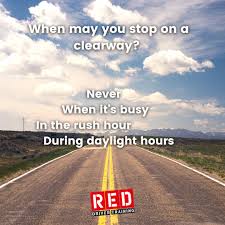
Introduction
If you’ve ever seen a road sign marked “Clearway” and wondered what it really means, you’re not alone. Many drivers are unsure about the rules—especially when you may stop on a clearway. The answer is simple but crucial: in most cases, you must not stop, with only a few legal exceptions. Understanding these rules helps you stay safe, avoid fines, and keep traffic flowing smoothly.
What Is a Clearway?
A clearway is a stretch of road where stopping is strictly prohibited. You’ll usually see a blue circular sign with a red border and a red diagonal line running through it. This sign means:
-
No stopping at any time during the hours shown (or 24/7 if no times are listed).
-
The restriction applies to all vehicles, including cars, vans, lorries, and motorcycles.
The main purpose of a clearway is to reduce congestion and keep traffic moving, especially on busy routes.
When May You Stop on a Clearway?
While the general rule is that you cannot stop on a clearway, there are a few important exceptions where it is permitted:
-
In an emergency – If your vehicle breaks down or there is an accident, you may stop for safety reasons.
-
To avoid danger – For example, if there’s an obstruction in the road ahead.
-
Directed by police or traffic officers – You must follow their instructions, even on a clearway.
-
Picking up or setting down passengers (in some cases) – Only if road signs explicitly allow it, such as at designated bus stops or taxi ranks.
If none of these situations apply, you should keep driving until you find a safe and legal place to stop.
Penalties for Stopping on a Clearway
Stopping on a clearway without a valid reason can lead to:
-
Fixed Penalty Notices (FPNs) – Usually a fine of around £50–£100.
-
Penalty points – Depending on the seriousness of the offence.
-
Vehicle removal – In some cases, authorities may tow your car if it’s causing an obstruction.
Not only can this cost you money, but it also creates a safety hazard for other road users.
Clearway vs Urban Clearway: What’s the Difference?
It’s easy to confuse the two, but here’s how they differ:
-
Clearway: No stopping at any time during the restrictions.
-
Urban Clearway: Stopping is prohibited during peak hours (usually shown on the sign), except for dropping off or picking up passengers.
How to Recognise a Clearway Sign
Look out for:
-
Blue circle with a red border and red diagonal line.
-
Additional time plates underneath that show when the restriction applies.
-
Repeated signs along the route to remind drivers of the restriction.
FAQs About Clearways
1. Can I stop on a clearway to answer a phone call?
No, you must not stop for non-emergencies. Pull over somewhere legal and safe.
2. What if I stop briefly to check directions?
That’s not allowed on a clearway. Find a layby or side road instead.
3. Can taxis or buses stop on a clearway?
Only in designated areas such as marked taxi ranks or bus stops.
4. Are clearways the same as red routes?
Not exactly. Red routes are found in major cities like London and have their own set of rules, though both are designed to prevent stopping.
5. What happens if my car breaks down on a clearway?
Switch on your hazard lights, pull over as safely as possible, and call for roadside assistance. This is considered a legal exception.
Conclusion
So, when may you stop on a clearway? Only in emergencies, when avoiding danger, or when directed by authorities. In all other situations, stopping is prohibited to ensure safety and traffic flow.